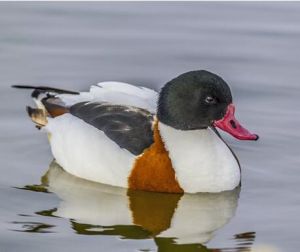Morphological Feature
Shelducks, males are dark - brown on head and neck, with a green gloss;Under the neck, back, back, tail and tail coverts are white, with horizontal black grouper Shelducks, males are dark - brown on head and neck, with a green gloss;Under the neck, back, back, tail and tail coverts are white, with horizontal black grouper . scapulars and primary flight feathers are dark - brown, the outer secondaries green metal, in which the fin is formed on a distinct green wing mirror;tertiary feather outside, chestnut wing coverts are white;An upper dorsal to the thorax has a broad chestnut forest.chest maroon belt with a black - brown longitudinal band after transabdominal to extend all the way to the anus;Lower tail coverts are brown and white, red and white
the rest of the lower nozzle, upper nozzle base in the breeding season have a prominent red hypernephroma the rest of the lower nozzle, upper nozzle base in the breeding season have a prominent red hypernephroma . female plumage with a small head and neck and a slightly lean female plumage with a small head and neck and a slightly lean .
also doesn't make green metal Guangyang, a small white spots on its forehead, brown - maroon breast band is narrower light - colored, abdomen black vertical band is also not very clear, mouth - cortical sarcoma also doesn't make green metal Guangyang, a small white spots on its forehead, brown - maroon breast band is narrower light - colored, abdomen black vertical band is also not very clear, mouth - cortical sarcoma . iris is brown or brownish crimson or purple - red mouth iris is brown or brownish crimson or purple - red mouth .
. feet are pink or red meat, black feet are pink or red meat, black .
claw size metric is: weight 500 1750 g of a male, a female 620 1200 grams;winged male 306 339 mm, females 270 308 mm, a tail male 98 136 mm;Female 95 - 117 mm, of males 50 - 65 mm, females 44 a 54 mm claw size metric is: weight 500 1750 g of a male, a female 620 1200 grams;winged male 306 339 mm, females 270 308 mm, a tail male 98 136 mm;Female 95 - 117 mm, of males 50 - 65 mm, females 44 a 54 mm .
Distribution Range
World Distribution
Afghanistan, Albania, Algeria, Armenia, Austria, Azerbaijan, Bangladesh, Belarus, Belgium, Bhutan, Bosnia and Herzegovina, Bulgaria, China, Croatia, Cyprus, Czech Republic, Denmark, Egypt, Estonia, Finland, France, Germany, Greece, Hong Kong, Hungary, Iceland, India, Iran (Islamic Republic of), Iraq, Ireland, Israel, Italy, Japan, Jordan, Kazakhstan, South Korea, North Korea, Kuwait, Kyrgyzstan, Latvia, Lebanon, Libya, Lithuania, Macedonia,Malta, Moldova, Mongolia, Montenegro, Morocco, Netherlands, Norway, Oman, Pakistan, Palestine, Poland, Portugal, Qatar, Romania, Saudi Arabia, Serbia, Slovakia, Slovenia, Spain (Canary Islands), Sweden, Switzerland, Syrian Arab Republic, Tajikistan, Tunisia, Turkey, Turkmenistan, Ukraine, United Arab Emirates, United Kingdom, Uzbekistan, Yemen Afghanistan, Albania, Algeria, Armenia, Austria, Azerbaijan, Bangladesh, Belarus, Belgium, Bhutan, Bosnia and Herzegovina, Bulgaria, China, Croatia, Cyprus, Czech Republic, Denmark, Egypt, Estonia, Finland, France, Germany, Greece, Hong Kong, Hungary, Iceland, India, Iran (Islamic Republic of), Iraq, Ireland, Israel, Italy, Japan, Jordan, Kazakhstan, South Korea, North Korea, Kuwait, Kyrgyzstan, Latvia, Lebanon, Libya, Lithuania, Macedonia,Malta, Moldova, Mongolia, Montenegro, Morocco, Netherlands, Norway, Oman, Pakistan, Palestine, Poland, Portugal, Qatar, Romania, Saudi Arabia, Serbia, Slovakia, Slovenia, Spain (Canary Islands), Sweden, Switzerland, Syrian Arab Republic, Tajikistan, Tunisia, Turkey, Turkmenistan, Ukraine, United Arab Emirates, United Kingdom, Uzbekistan, Yemen . birds: Bahrain, Ethiopia, Ghana, Gibraltar, Guinea - Bissau, the Lao Peoples Democratic Republic, Liechtenstein, Luxembourg,Mauritania, Myanmar, Nepal, Philippines, Senegal, Sudan, Thailand, Viet Nam birds: Bahrain, Ethiopia, Ghana, Gibraltar, Guinea - Bissau, the Lao Peoples Democratic Republic, Liechtenstein, Luxembourg,Mauritania, Myanmar, Nepal, Philippines, Senegal, Sudan, Thailand, Viet Nam .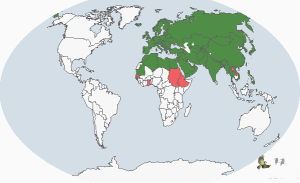
China's Distribution
Distributinging Yu Heilong river, Jilin, Inner Mongolia, Gansu, Qinghai and Xinjiang Distributinging Yu Heilong river, Jilin, Inner Mongolia, Gansu, Qinghai and Xinjiang .
Living Habits
Migration
Shelducks, breeding mainly inhabits open grassland plains of salty, alkaline and freshwater lakes, coasts, islands and marshes Shelducks, breeding mainly inhabits open grassland plains of salty, alkaline and freshwater lakes, coasts, islands and marshes . migratory and overwintering period also inhabit the shallow bay, freshwater lakes, reservoirs, estuaries, beaches and seaside Yantian migratory and overwintering period also inhabit the shallow bay, freshwater lakes, reservoirs, estuaries, beaches and seaside Yantian .
like like . lived in groups during the winter, especially, often integrates dozens to hundreds of large flocks of lived in groups during the winter, especially, often integrates dozens to hundreds of large flocks of .
is in pairs during breeding is in pairs during breeding . headlong flight, the wings and inciting faster headlong flight, the wings and inciting faster .
good swimming and diving, also good good swimming and diving, also good . walk on earth for a sharp run walk on earth for a sharp run .
of alertness, Chang constantly stretched his neck to look around of alertness, Chang constantly stretched his neck to look around .
Feeding Habits
Shelducks, primarily aquatic insects, insect larvae, algae, mollusks, snails, oysters, sea snails, sea worm, leeches, lizards, grasshoppers, crustaceans, insects, fish, eggs and animal foods such as fish and also eat leaves, buds and seeds and other plant food Shelducks, primarily aquatic insects, insect larvae, algae, mollusks, snails, oysters, sea snails, sea worm, leeches, lizards, grasshoppers, crustaceans, insects, fish, eggs and animal foods such as fish and also eat leaves, buds and seeds and other plant food .
Habit
Shelducks, annually in early March to begin to leave the breeding grounds and wintering vemoved up north, reaching the northeast of breeding time in early April to mid - April.Northwest arrives at the time of the breeding grounds in late April and early May.Autumn starts in late September to leave the breeding grounds and wintering, 10 to 11 at the end of the month arrived earlier in the southern wintering when the birds are mostly family groups and small group when the birds are mostly family groups and small group .
migration routes along the coast and major rivers cease foraging and endless migration routes along the coast and major rivers cease foraging and endless . .
Procreation
Shelducks, 2nd instar when sexually Shelducks, 2nd instar when sexually . usually overwinter on i.e. have been formed, but also along the migratory routes and breeding grounds is not formed until after the arrival of
mating in the water, sometimes in a land based breeding mating in the water, sometimes in a land based breeding . 5 July 5 July .
Nest in coastal and lakeside dunes or Shek Pik between, sometimes also in open grassland on the natural caves or orphaned, abandoned and rabbits in the burrow nesting Nest in coastal and lakeside dunes or Shek Pik between, sometimes also in open grassland on the natural caves or orphaned, abandoned and rabbits in the burrow nesting . caves have an invasion depth of 4 meters caves have an invasion depth of 4 meters .
. Chao is dish - shaped multi - gramineous plants, Achnatherum splendens (Trin) Nevski, bird bone and fish bone form Chao is dish - shaped multi - gramineous plants, Achnatherum splendens (Trin) Nevski, bird bone and fish bone form .
within the pad to a large number of down feather within the pad to a large number of down feather . height was 8 cm, 6 cm deep, inner diameter of 17.5 cm,the outer diameter of 26 cm per nest spawning
7 7 . 12 typically 8 to 10 12 typically 8 to 10 .
egg is elliptical, the color is pale yellow or milk white egg is elliptical, the color is pale yellow or milk white . of the size of the egg is 62 42 70 x 51 mm;The egg mass 69 78 grams a day usually of the size of the egg is 62 42 70 x 51 mm;The egg mass 69 78 grams a day usually .
. finishing laying the last egg after the incubation start by finishing laying the last egg after the incubation start by .
brooding females assume alone and the male's nest in the vicinity of the warning, when there is danger when males immediately sound alarm calls, at the same time to fly and brooding females assume alone and the male's nest in the vicinity of the warning, when there is danger when males immediately sound alarm calls, at the same time to fly and . females leave the nest a day to be out, you are down in between the egg is covered, even in the relatively deep in the cave is no exception females leave the nest a day to be out, you are down in between the egg is covered, even in the relatively deep in the cave is no exception .
hatchery incubation of the last two days, the female did not leave the nest and incubates the Ming hatchery incubation of the last two days, the female did not leave the nest and incubates the Ming . 27 29 days 27 29 days .
. precocial chicks hatched shortly after carrying on its activities, while exclusively from coming out of the nest, the birds move into water activities for more than a month after precocial chicks hatched shortly after carrying on its activities, while exclusively from coming out of the nest, the birds move into water activities for more than a month after .
nestlings i.e. with the ability to fly,but still with the parents live together, until the spring of 2002 agriotos. 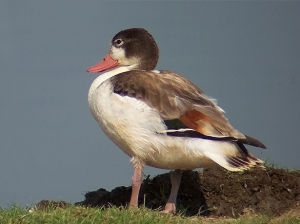
Economic Value
Shelducks, Shelducks, . it is hunting birds in the white feather duvet is in the firsts, the price is very high, often sold abroad it is hunting birds in the white feather duvet is in the firsts, the price is very high, often sold abroad .
its wing mirror (Green or duck - feather) black - and - green metal luster as a decorative plume its wing mirror (Green or duck - feather) black - and - green metal luster as a decorative plume . flesh does not smell delicious and often other flesh does not smell delicious and often other .
.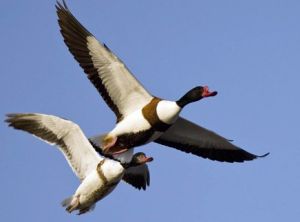
Subspecies Differentiation
single species and no subspecies single species and no subspecies .
Present Situation Of Population
Shelducks, China's population is very rich, because they are hunting one of Shelducks, China's population is very rich, because they are hunting one of . but their population numbers in the past had or had not been assigned to investigate the but their population numbers in the past had or had not been assigned to investigate the .
International Waterfowl Research Bureau 1990 asian waterbird census in China, where there are only 19188, 475 only Japan, South Korea only 177, Bangladesh only 359, 656 only India, Pakistan only 416, a total of about 25,000 in the region in Europe is only International Waterfowl Research Bureau 1990 asian waterbird census in China, where there are only 19188, 475 only Japan, South Korea only 177, Bangladesh only 359, 656 only India, Pakistan only 416, a total of about 25,000 in the region in Europe is only . .
13 million of the total world population of about 150,000 13 million of the total world population of about 150,000 . of the species' wide distribution,not close to the survival of the species endangered the fragile threshold standard (or the distribution area of the fluctuation range of less than 20000 km2, the quality of the habitat, population size, fragmented distribution area), the population trend is stable; therefore, it is evaluated that there is no crisis of survival of the species of the species' wide distribution,not close to the survival of the species endangered the fragile threshold standard (or the distribution area of the fluctuation range of less than 20000 km2, the quality of the habitat, population size, fragmented distribution area), the population trend is stable; therefore, it is evaluated that there is no crisis of survival of the species .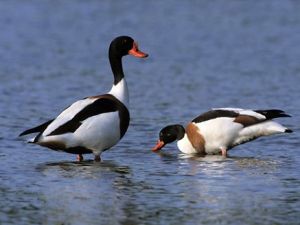
Species Protection
The World's Union for the Conservation of Nature (IUCN), the International Bird Redbook, 2009 List ver 3.1 included the Chinese State Forestry Administration on 1 August 2000 issue of the List of Nationally - protected Land Wild Animals of Benefit, Financial Value and Scientific Research Value included the Chinese State Forestry Administration on 1 August 2000 issue of the List of Nationally - protected Land Wild Animals of Benefit, Financial Value and Scientific Research Value .
1 1.
